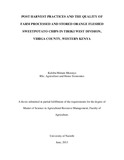| dc.description.abstract | Post-harvest handling of sweetpotatoes (Ipomoea batatasi is relevant to enhance
food safety and security for rural households. An observational study on post-harvest
handling practices on sweetpotato farmers and determination of levels of beta-carotene,
fungi and mycotoxins contamination in farm processed sun-dried orange fleshed
sweetpotato chips was done. This was carried out between December 2004 and May 2005
in Tiriki West Division ofVihiga County. The purpose of the study was to promote food
safety and food security through identification of practices that predispose sweetpotatoes
to fungal infection with the relevant mycotoxin contamination.
Questionnaires were used to gather information on production, preparation,
storage and handling practices of sweetpotato tubers. Samples of sun-dried orange
fleshed sweetpotato chips of SPK 004 sweetpotato variety were then collected from the
farmers for determination of beta-carotene, fungal and mycotoxin levels. Beta-carotene
level was determined using the column chromatography technique. Fungi were isolated
by direct plating and the fungi identified either to genera or species level. Aflatoxin and
ochratoxin A levels were determined using ELISA method. Data were analyzed using
SPSS Version 12 software and Excel.
Most farmers (67.8%) planted orange fleshed sweetpotato varieties. Thirty four
point five percent of the farmers prepared and dried the sweetpotato roots into chips and
majority (80.0%) used traditional locally available tools to do the preparation. Most of
the farmers (53.3%) dried the chips by exposing them directly to the sun and majority
(66.7%) of the farmers dried the chips for more than two days. Most farmers stored
XlI
sweetpotato chips anywhere (63.3%) in the house for a period of over three months
(63.3%).
Beta-carotene levels were between 1.00 mg to 6.10 mg per 100g sample. The
study also found that beta-carotene decreased with storage time. The major fungal genera
isolated from the dry chips were Aspergillus, Fusarium, Penicillium, Trichoderma,
Rhizoctonia, Nigrospora, Rhizopus, Alternaria and Microsphaera. Aspergillius species
isolated and identified were Aspergillus jlavus, Aspergillus parasiticus, Aspergillus
ochraceus and Aspergillus niger. It was found that the levels of Aspergillus increased
with the storage length of the dry chips, and the levels of Fusarium decreased with the
storage length of the dry chips. The study also found that levels of Aspergillus and
Fusarium were associated negatively.
Aflatoxin assessment indicated that the levels ranged from undetected level to
twelve parts per billion while ochratoxin A assessment recorded levels that were
undetected to fifteen parts per billion. Seventy percent of the samples recorded detectable
levels of aflatoxin whereas 90% of the samples recorded presence of ochratoxin A.
Aflatoxin levels and ochratoxin A levels in the farm prepared sun-dried sweetpotato chips
were found to be significantly associated.
Association analysis showed the longer the storage length for the sun-dried
orange fleshed sweetpotato chips the more the levels of species of Aspergillius and the
lower the levels of beta-carotene in the samples. Association analysis also showed a
negative association between species of Aspergillus and species of Fusarium, and a
negative association between moisture content and aflatoxin levels.
The results of the study showed that beta-carotene level, fungal, aflatoxin and
ochratoxin A contamination in the farm processed sun-dried orange fleshed sweetpotato
chips could be as a result of post-harvest handling practices. All the samples were
susceptible to fungal, aflatoxin and ochratoxin A contamination.
This study concludes that there is safety and health risk associated with utilization
of the sun-dried sweetpotato chips and products made from the chips. This study
recommends training of farmers on post-harvest handling of sweetpotatoes, further
research to be done on association of beta-carotene levels and growth of fungi, aflatoxin
and ochratoxin A in sun-dried sweetpotato chips under controlled study conditions of
temperature, relative humidity and time. | en |

